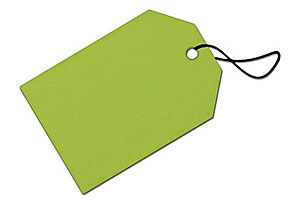
|
Doesn’t the word price just wear you out?
Getting pressure on pricing from every angle gets old. Real old. And from what I’m hearing from many of you it’s gotten worse than ever before.
My guess would be the combination of the recession and the Internet has caused folks to do more price shopping than they ever have. I hate it, you hate it, but unfortunately it is what it is. Learning to deal with it in a strong, positive and well-thought-out manner is the key.
Learning how to price products and projects always has been a huge challenge, and doing it in a way that keeps the doors open and the owners happy has been a battle for as long as I can remember.
My first job after college, the Army and getting an MBA was working for a large plumbing/HVAC wholesaler in Pennsylvania. Learning how to make a respectable margin on sales was tough then and it’s still tough today.
Wholesalers are affectionately referred to as the “middle man” and for a good reason. They purchase products in bulk from manufacturers and in turn break those products down into smaller quantities and resell them to their customers.
But they also are the “middle man” when it comes to pricing. Those same manufacturers dictate how much you have to pay for the product and the tradespeople have learned how to dictate how much they will pay for it. This doesn’t leave much room for those all-important gross-profit dollars that are needed to pay the ever-growing operating expenses of the business.
That’s why management puts so much emphasis on doing a good job managing those operating expenses, inventories and accounts-receivable. It’s the difference between making a reasonable return on investment and going broke. The margin for error is very slim. I believe national averages show gross-profit margins in the low 20s and operating expenses in the high teens. That doesn’t allow a whole lot of money to flow to the all-important bottom line. So yes, ours is a tough business, but when managed extremely well it’s also a great business.
Certainly the various buying groups have helped the wholesalers a lot (although I’ve always wondered how the manufacturers feel about sharing some of their hard-earned profits with these various “rebate” programs). I do know that some wholesalers can double their bottom lines by what they receive back in rebate dollars from the various buying groups — and that’s a good thing. And now there are a couple buying groups for the decorative and luxury products. Have you looked into these?
In my heart I believe the showroom side of the business is different. Wishful thinking tells me there shouldn’t be so much pricing pressure on showroom sales. Heck, with the higher cost of operating a showroom and all the darned hand-holding it takes to maintain satisfied happy customers, it should be easier to make good margins. Unfortunately, in too many cases it’s not. Showrooms are being squeezed by the tradespeople and now even the homeowners. Geez — can’t we catch a break anywhere?
A different animal
The main reason I believe showrooms should enjoy less pricing pressure is that operating a showroom costs more — quite a bit more. You’ve got the expensive build-out. You invest a lot of money to put products on display and they just sit there looking pretty. No “turn and earn” there.
You’ve got higher utility costs, cleaning costs, change-out costs and those all-important marketing costs (something you don’t do as much of on the wholesale side). Now combine this with the fact it’s a totally different business model. It’s a retail-oriented business, very different than wholesale. It takes a totally different skill set to be successful.
Please allow me to go back to the early 80s when I left the wholesale side of the business and opened one of the first true decorative plumbing and hardware businesses in the U.S. Times were different. There were very few truly decorative products. The kitchen and baths were still purely utilitarian rooms that hadn’t evolved into today’s main rooms in the home. The major fixture and faucet manufacturers were just starting to experiment with different styles, colors and finishes.
In spite all this, I leased a much larger space than I needed, mainly because it was a great location on a very busy freeway and next door to a large tile showroom.
Now here’s the really important part of the story. After working on the wholesale side and struggling with those tight margins, I made a commitment to my wife, my banker and myself that the margins of our new business were going to be 40% plus or minus 2%. My goal was to be profitable, not big.
Not being a wholesaler, I had to buy the major fixture and faucet products through local supply houses. I had naively believed my local plumbing contractor “friends” would be happy to use my all-new and beautiful showroom.
My message to them was let me do all the selling work for you and allow me to make a fair margin doing it. Wrong. If I couldn’t sell them at the same deep discounts they were getting from the wholesaler, there would be no sale. Needless to say this caused me to immediately change my marketing strategies. We marketed this new business to the custom homebuilders, remodel contractors, designers, architects and homeowners. They loved the total service package we offered. They were thrilled to be able to see and touch the products vs. having to buy them by looking at catalogs.
Since it really was the homeowner that was making the various style, color and finish selections — and it was their money — we had a lot of success right out of the chute. From the beginning, we hit our 40% margin goals month in and month out. Of course, we got lucky when the kitchen and bath did become the featured rooms in the home and all those great decorative products started coming out. And yes, we did a pretty good job managing the overall business.
Over the next 15 years the business grew to three stores and evolved into a one-stop shopping source for the kitchen and bath. We sold kitchen cabinets, appliances, counter tops, door hardware and much more. When we sold the business to a large wholesaler, our margins were in the high 30s and that was competing with several wholesaler showrooms that were selling at deeper discounts than we were.
The modern-day margin
That’s enough of a history lesson. Where are we today? Unfortunately we’re still fighting price, price and more price. Our Supply House Times surveys continually show wholesaler showroom margins in the low 30s.
In my humble opinion that’s too darned low! Depending on the spread of business between tradespeople, builder and homeowner, margins should be between 35% and 40%. You deserve it. You need it. Wholesalers buy better than the independently owned showrooms (at least on the major fixture and faucet lines), so shouldn’t they be making higher margins? The sad fact is they don’t. The independently owned showrooms average 40% and more. Honest. I know.
In my previous column (June 2014 issue), I interviewed three independently owned showroom owners. I asked what their margins were and they were happy to share they enjoyed margins in the low 40s. Yes, I know they aren’t selling those tough old plumbers. But hey, you shouldn’t be extending the same discounts to them on showroom sales that you do over the counter and out the warehouse door. I’ve preached on this several times in the past. This is pretty simple. If the showroom is a higher cost operation don’t you have to make higher margins to cover those costs? Pretty simple logic, wouldn’t you agree?
Of course, one big difference between the independents and the wholesaler is the independents focus on the homeowner, builder and designers, while wholesalers concentrate on the plumber. They are the core customer. So maybe expecting margins in the 40s isn’t realistic, but setting a goal of 35% would be realistic. And as the homeowner portion of the business grows so should the margin. I guess I have the question, “Who is running your business, the plumber or you?”
Big doesn’t make good; it’s how profitable you are that makes good. I’ve had the pleasure of doing consulting work with several-dozen wholesalers and with a bit of coaching I’ve seen many of these folks raise margins by as much as five and seven points. This is huge when you consider it all goes to the bottom line. I’d be almost willing to guarantee my consulting fee that I could help you increase your showroom margin by at least two points. Try me!
Margin advice
There are a number of things you can do to inch up your margins. And yes, I mean inch up. A point here, another point there. It takes discipline and commitment. Let’s look at a few of the more obvious actions you can take:
- Teach and practice selling skills. Learn to sell value and learn how to sell to maximize the margin.
- Identify your higher-margin products and push them.
- Display and sell products not sold by everyone. Find some unique and different products to mix in with the products everyone shows and sells.
- Mix up the discounts. Don’t do across-the-board discounting. Be creative in your pricing. Don’t do the same discount on the accessories that you do on the faucets, etc.
- Do different discounts to the plumber on products purchased through the showroom.
- Do a compensation program that rewards higher margins.
- Direct a stronger marketing program to builders and homeowners. Grow that side of the business and watch the margins climb.
- Learn how to be a retailer and great merchandiser.
- Don’t lock all the pricing into the computer. Give sales consultants the leeway to move prices up and down — with limits on the low side.
A commitment to improved margins starts at the top. When top management gets serious about this and develops a written well-thought-out price-management system and teaches everyone the importance of it and how to sell for increased margins, you will have a shot at achieving those much-needed higher margins. Good selling!



